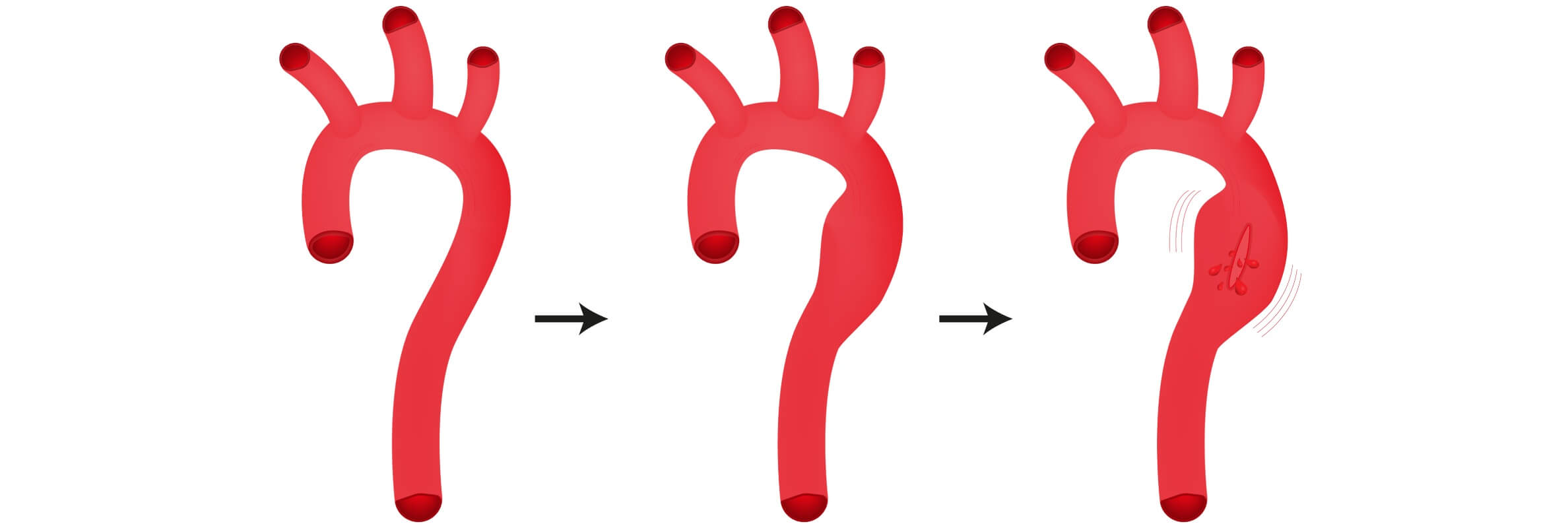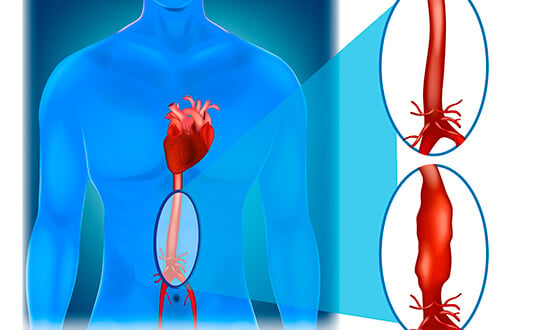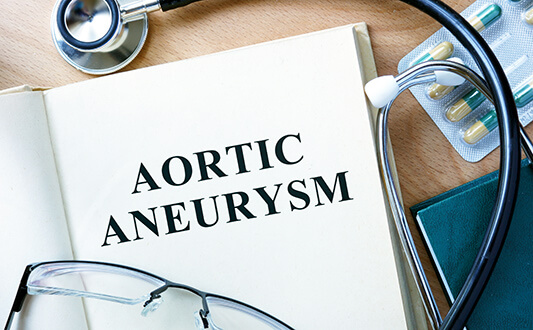- Causes of Abdominal aortic aneurysm
- Clinical signs
- Diagnostics
- Abdominal aortic aneurysm rupture
- Is conservative treatment possible?
- Indications and contraindications for a surgery
- Arrangement of treatment in Germany
What is an abdominal aortic aneurysm? Is it a dangerous disease? Does it require emergency care or will it be enough to just observe it? Let’s also talk about the abdominal aortic aneurysm definition, its causes, symptoms, diagnostics and treatment.
Causes of Abdominal aortic aneurysm
Abdominal aortic aneurysm – is a disease when the diameter of a certain aortic site expands and becomes 2 or more times bigger than the normal width of the aorta. Pathology is dangerous because at any time an aneurysm can rupture. This deadly complication in many cases ends in a fatal outcome. Abdominal aortic aneurysm can have different causes, but one of them dominates over the others. Atherosclerosis causes this illness in 96% of cases. All the other causes of an abdominal aortic aneurysm make up only 4% of cases.
These causes include:
- Syphilis
- Congenital defects of connective tissue
- Nonspecific aortitis (inflammatory processes of bacterial etiology)
- Tuberculosis
- Injuries
- Surgery and diagnostic procedures
Different areas of the aorta can expand. They are divided into 4 types by location:
- The proximal part (closest to the diaphragm)
- Infrarenal abdominal aortic aneurysm without involving bifurcation (this is the place where the aorta divides into 2 iliac arteries)
- The same localization with bifurcation damage
- Expansion of the entire abdominal aorta
In 90% of cases type 2 or 3 of the diseases is diagnosed. It means that the infrarenal area of the aorta is damaged, which is lower than the branch of the renal artery.
Clinical signs
The majority of abdominal aortic aneurysm symptoms are determined by the compression of the closely located anatomical structures. It depends on what kind of tissues are compressed which symptoms of the abdominal aortic aneurysm the doctor will detect.
Abdominal pain in the abdominal aortic aneurysm is the main clinical sign of the pathology. The symptom is observed in 90% of patients. Often, abdominal pain becomes a reason to visit a doctor. It appears due to the compression, when the expanded aortic part influences the nerve plexuses.
Pain will be dull, aching. Its location is often around the navel area, though it can irradiate into the groin, lower back and even legs. Sometimes the intensity of pain significantly increases; there are signs of an acute abdomen pain. This occurs in the case when the aneurysm begins to press on the spinal roots.
The second symptom of the abdominal aortic aneurysm is the feeling of strong pulsation. It’s observed in 40% of patients. The feeling is often accompanied by the feeling of fullness, discomfort in the stomach. When palpating, volume formation is most often determined in the left half of the abdominal cavity. Usually, pulsation appears only when an aneurysm reaches a large size. This indicates an increased risk of its rupture.
Third and main symptom of the abdominal aortic aneurysm is determined during the examination. The exam presupposes auscultation - listening of the abdominal wall by means of the a phonendoscope. In 75% of patients, systolic murmur over the enlarged aorta is determined. It is caused by the trembling of its walls.
Other symptoms of the abdominal aortic aneurysm are variable. They occur with a small frequency in different patients.
Among the main clinical symptoms should be allocated:
- Ishioradicular - soreness in the lower back and deterioration of leg mobility when the motor and sensitive spinal nerves are squeezed.
- Abdominal - eructation, vomiting, stool disorders, deterioration of appetite, weight loss. These occur in case of the duodenum compression.
- Urologic - blood in the urine, pain and heaviness in the lower back, difficulty in urinating. It is associated with compression of the kidney and urethra.
- Chronic ischemic - occurs when the femoral and iliac arteries are squeezed, manifested by pain in the legs, which increases with walking.
Symptoms of the abdominal aortic aneurysm give a possibility for a doctor to suspect this pathology. However, the final diagnosis can only be established by means of the instrumental tests.
Diagnostics
Abdominal aortic aneurysm is revealed with the help of non-invasive imaging techniques. Basically, these are ultrasound, X-ray methods or MRI.
- Ultrasound. This is the most simple, safe and inexpensive method of research. It can be prescribed with a preventive purpose to males after 50-60 years of age, even if they have no complaints. During this procedure, an abdominal aortic aneurysm can be detected. In addition, ultrasound makes it possible to assess the condition of its wall, to detect thrombosis, to clarify the magnitude and location of the enlarged fragment of the artery.
- CT. Computed tomography is a precise method for diagnosing abdominal aortic aneurysm. It allows you to detect thrombotic masses and damage to the inner shell of the artery. With the help of CT, a doctor assesses the condition of nearby organs. MRI. MRI can also be carried out with a clarifying purpose. This method allows you to see the details even better. Thanks to the MRI, the doctor discovers calcifications, damage and stratification of the aortic walls, as well as other morphological features.
- Angiography. This method of investigation is unsafe, because at the time of its conduct there is a risk of breaking the aorta. Therefore, it is rarely prescribed for diagnosing the abdominal aortic aneurysm. This is an x-ray method of diagnosis, suggesting the introduction of contrast. It is used to check the condition of the aortic branches, or to obtain a more accurate picture of the disease before the operation.
Abdominal aortic aneurysm rupture
This disease is one of the most dangerous vascular pathologies. The prognosis is unfavorable. Abdominal aortic aneurysm rupture occurs in 40% of patients during the first year after diagnosis. Mortality with this complication reaches 60%.
The disease is constantly progressing, the diameter of the aneurysm increases with age. In a year, it grows by an average of 2-3 mm. As a result, the outer shell of the artery plays the role of the framework of this large vessel. Naturally, it is not capable of withstanding such a strong pressure for a long time. Moreover, because of the turbulence of the blood flow, it increases. That is, in the dilated part the pressure is higher than in the rest of the aorta. As a consequence, there is a break with massive internal bleeding.
Abdominal aortic aneurysm is ruptured more often with a large diameter of the expansion. A direct relationship between the size of the aneurysm and the risk of its rupture is already established. So, with an expansion diameter of less than 5 cm, the risk of rupture is about 5%. If the diameter exceeds 7 cm, then the probability that the aneurysm rupture reaches 76%. The risk increases if the patient suffers from uncompensated hypertension.
Is conservative treatment possible?
Abdominal aortic aneurysm treatment is impossible. There is no pill to take that would decrease the expanded size of the vessel back to normal. Abdominal aortic aneurysm treatment with traditional (alternative medicine) means doesn’t make any sense. Decoction of burdock or nettle root will not affect the structure of your blood vessels. When an abdominal aortic aneurysm is detected, treatment can be performed only by surgical methods.
The question of the need for an operation is decided in each case individually. If an aneurysm is identified, the patient is referred to the department of vascular surgery. Then the doctors assess the risk factors and decide whether the operation is needed now or it can be postponed to a later date.
Most specialists are inclined to believe that if the abdominal aortic aneurysm is detected, treatment is always required if it has a diameter of more than 4 cm. It does not matter whether the patient has complications of the disease and what the age is.
Indications and contraindications for a surgery
In case of detecting an abdominal aortic aneurysm treatment has to be started as early as possible. First of all, it’s done to prevent its rupture. Second, it has to be done to prevent complications of the disease. That’s why the observation tactics doesn’t make any sense. Especially, if one considers that aorta constantly expands. Sooner or later, abdominal aortic aneurysm surgery is obligatory. But, it’s better to perform it earlier to prevent irreversible complications. However, a number of cases exist when surgical treatment has to be postponed. Many patients stop before the cost of the operation. Abdominal aortic aneurysm may also not be cured by a surgical method due to medical contraindications.
The main ones are:
- Disorders of coronary or intracerebral circulation
- Renal or hepatic insufficiency
- Suffered heart muscle infarction less than 3 months ago
Surgical treatment is performed only if the patient's condition is compensated. The operation can be emergency or planned. The emergency surgery is different in that it is carried out as soon as possible. It is indicated with a threatening rupture of the aneurysm. Regardless of the presence of symptoms, treatment of an abdominal aortic aneurysm is prescribed for the majority of patients.
The operation is conducted in a planned manner. Its essence lies in the fact that artificial prosthesis is installed inside the enlarged aorta site. It can be linear or bifurcational. The stitched ends of the artery are fixed with clamps during the operation to prevent hemorrhage. When performing an abdominal aortic aneurysm surgery, the price of it depends to a certain extent on the quality of the prosthesis to be installed.
Access can be open or endovascular. With open access, a laparotomy is performed. That is, the abdominal wall is opened. Endovascular access is more preferable. The price of the operation is approximately the same.
But during the surgical intervention with intravascular access it is ensured:
- A shorter period of rehabilitation
- Better post-operative tolerability
- Less risk of complications
- Better aesthetic effect
Endovascular access is through the femoral or iliac artery. This method is used in severe patients who cannot transfer an open operation.
Arrangement of treatment in Germany
Many patients prefer to undergo an abdominal aortic aneurysm surgery in one of the German clinics. This choice is due to the fact that surgical intervention with an aneurysm is very dangerous, and in clinics in developing countries the postoperative survival rate reaches 95%.
The cost of abdominal aortic aneurysm surgery in Germany is higher than in post-Soviet countries, but much lower than in the US, Switzerland or the UK. In the best German clinics there is less intra-operative mortality, lower risk of complications, better long-term results of treatment. In Germany a higher tolerability of surgery is ensured, because the patient is provided with quality post-operative care and modern anesthesia.
We can arrange treatment for you in one of the best German hospitals.
Booking Health has direct contracts with all major medical institutions in this country, which will allow you to:
- Reduce the waiting time for the operation
- Reduce treatment costs by up to 70%
- Use the services of the best German doctors, not the young specialists of little-known clinics
We will provide all necessary services and completely arrange your trip to Germany for treatment. We will provide you with an interpreter, help with visa processing, translation of documents, book tickets and a hotel for you, meet you at the airport in Germany. To use the services of Booking Health, leave a request on the website, and we will contact you in the nearest future.
Choose treatment abroad and you will be sure to get the best results!
Authors:
This article was edited by medical experts, board-certified doctors Dr. Nadezhda Ivanisova, and Dr. Sergey Pashchenko. For the treatment of the conditions referred to in the article, you must consult a doctor; the information in the article is not intended for self-medication!
Our editorial policy, which details our commitment to accuracy and transparency, is available here. Click this link to review our policies.
Sources:
ECR - European Cardiology Review
National Center for Biotechnology
JAHA - Journal of the American Heart Association
Read:
Don't know where to start?
Contact Booking Health







